The art of growing vegetables indoors is easy to learn and wonderfully satisfying. Yet many city-dwellers and suburbanites haven’t even considered the possibility. There’s an assumption that, if there’s no garden, there’s no point cultivating your own food.
This is, I think, this is a great shame. The absence of outdoor space or balcony shouldn’t destroy the possibility of a garden, big or small, that’s home to a myriad of lush, healthy edibles.
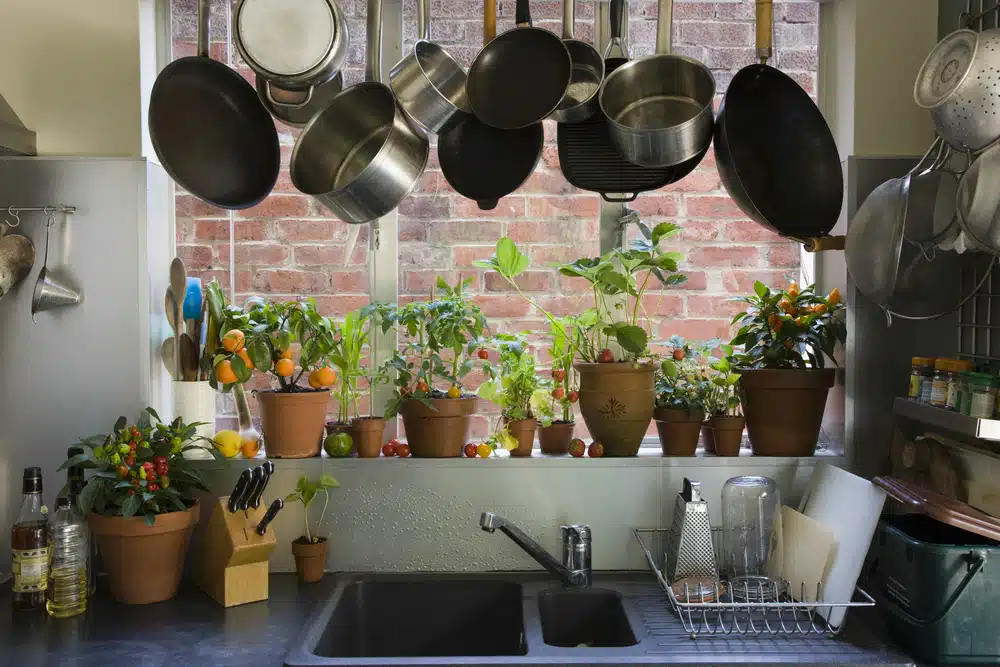
Basic principles still apply but their application is a tad different. Soil, for example, needs to be given more consideration, alongside light, temperature and variety selection. You might also have to recreate certain outdoor conditions – like wind and airflow – to ensure healthy plants.
This little guide will give you a good grounding in all the essentials. You could, in fact, be eating your own produce in only a few weeks.
Want to find out how? Keep on reading…
Jump to: Soil | Light | Pots & Containers | Common Pests | Vegetable Guide
The life cycle of a plant
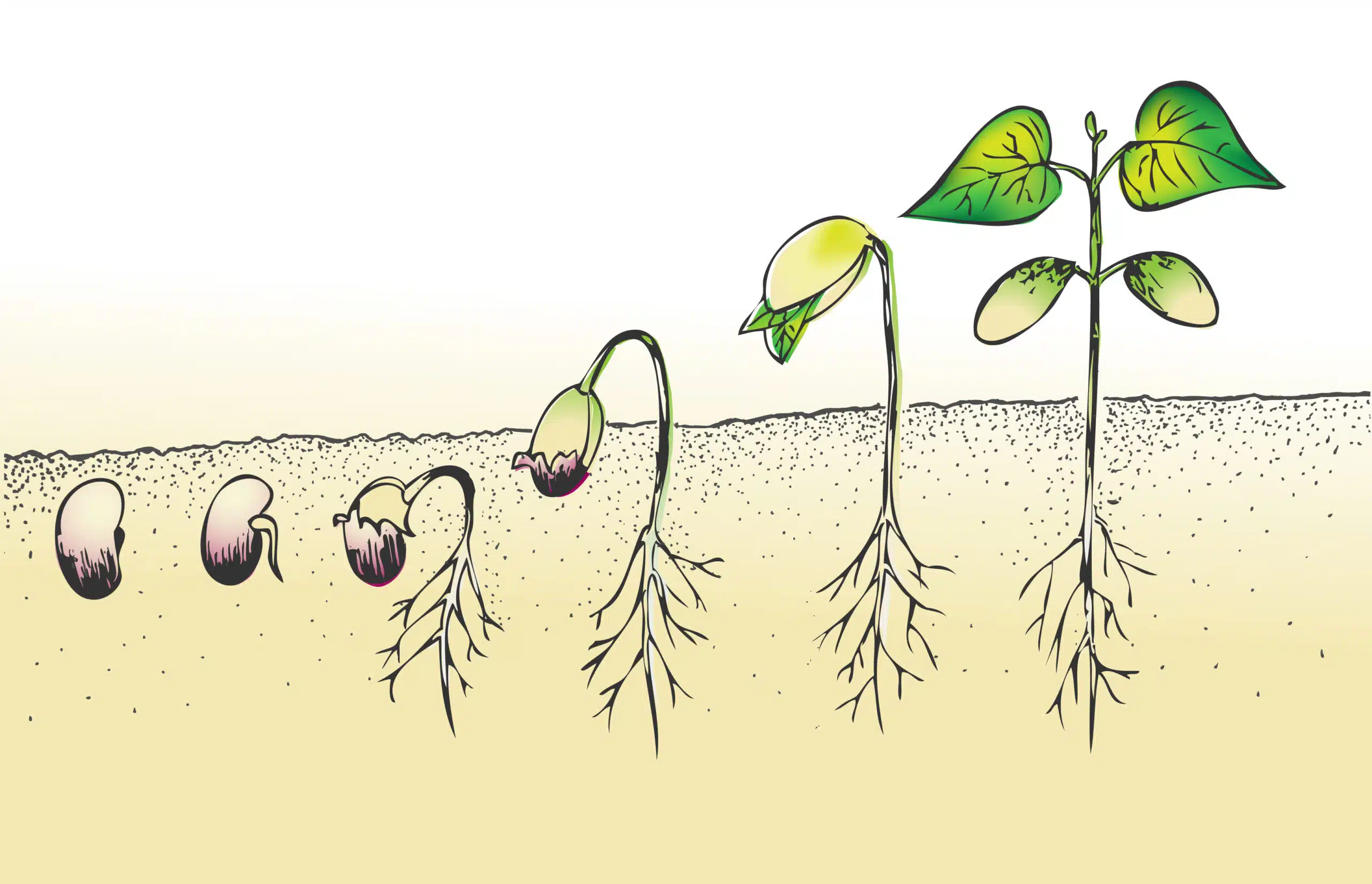
As you can see from the bean seedling above, there’s nothing particularly complicated (at least on the surface) about a plant’s early growth. The three stages below give a rough outline of an average life cycle.
1. Germination
Given the right conditions, usually moisture, warmth and in some cases also light or darkness, a seed sprouts and develops into a young seedling. All the nutrients required for this stage of the plant’s life are contained in the seed.
The plant puts out roots to take in nutrients from the soil, and leaves to photosynthesise sunlight. Edible gardeners will often eat seedlings in this stage of growth as “sprouts”, which are grown without soil, or “shoots”, which do require soil but are grown in shallow containers.
2. Vegetative Growth
The plant continues to develop, putting out a root network and growing more leaves. Vegetable plants begin to develop tubers. In a natural environment these roots would act as energy stores for flowers and fruit development and new growth in subsequent years.
3. Flowering
Plants will then put out flowers. In a fruiting plant, such as tomatoes or peppers, a fruit will grow in place of the flower once it has died. Other plants may develop a seed pod in place of the flowers.
Maturity is defined by you. Herbs and salad leaves are picked whenever edible. Vegetable plants will continue to develop their tubers or roots until they are ready for harvest, often indicated by “shouldering” (where the top of the root pushes just above the soil line). Fruit is obviously ready when ripe enough to pick.
Soil
We’re surrounded by soil and utterly dependent on it. It’s a necessity of life on earth and it would be impossible to grow anything without it. So let me put a a simple question to you:
What is soil?
Take a moment to try and come up with an answer…without asking Google for help. It’s a term that, though we all know what it means, is very difficult to define.
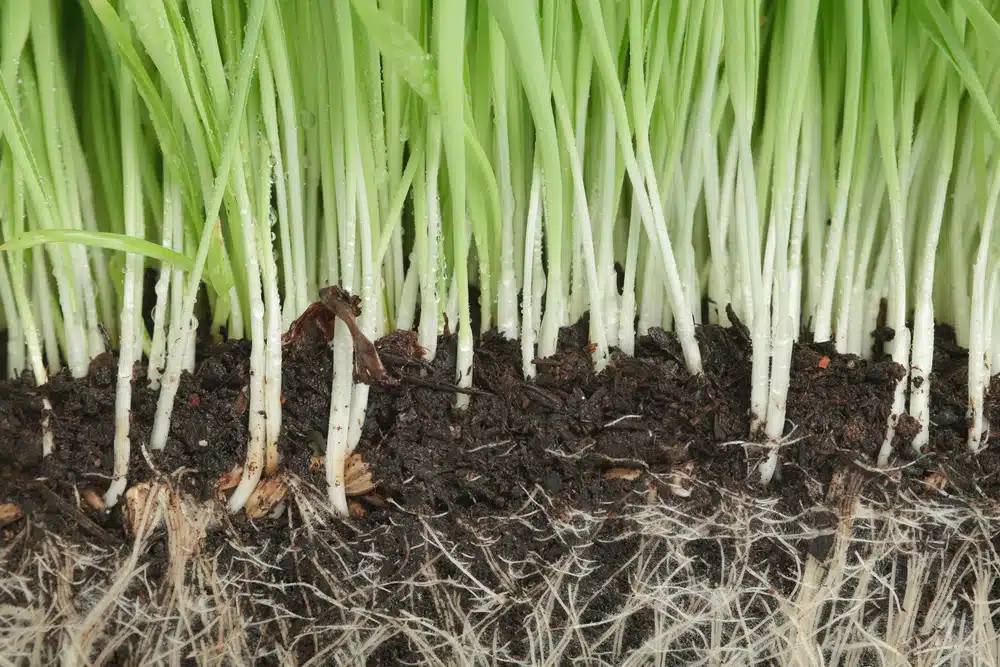
I’d like to propose a relatively simple answer: soil is any mixture of organic and non-organic materials and micro-organisms that can sustain plant life. There’s a lot of similar-sounding products on the market and a lot of terms are used interchangeably, so let’s have a quick look at what they mean…
What is soil?
Compost is any mix of organic material (usually manure, vegetable waste and biodegradable packaging like egg boxes) that has undergone a decomposition process.
A potting mix is any combination of materials (compost might be included) for potted plants.
Often, the multi-purpose compost that you buy at garden centres is a blend of rotted matter (compost proper) and other materials like peat or coir.
A soilless potting mix is (usually) any mix that doesn’t contain soil that resembles the type you would find in your garden (mineral content is usually absent). Soilless and potting mixes tend to require additional fertilizer because nutrient-density is low.
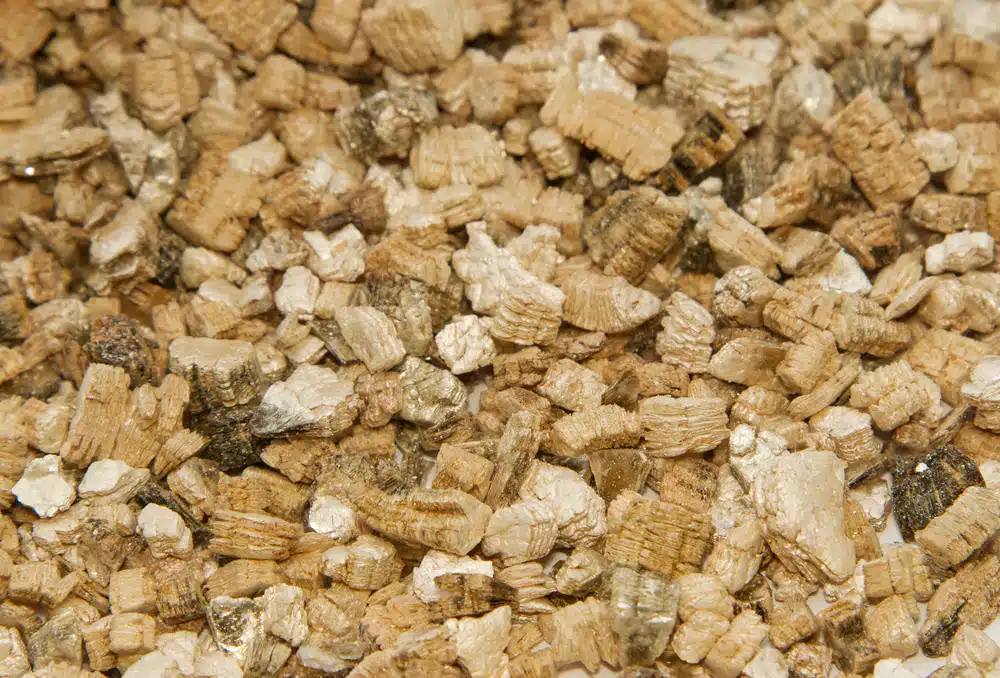
What’s in a potting mix?
Some of the common (non-decomposed) materials used in potting mixes are vermiculite, perlite, coir (coconut fibre), bonemeal, bark and peat. Vermiculite, a mineral that’s heated to a popcorn-like texture, can be particularly useful for gardeners as it helps to promote growth and aids in water retention.
Indoors, your main task is to limit the likelihood of bugs and harmful bacteria, as many natural defences (pests of the pests) aren’t present. Avoid garden soil like you would a human-size Venus flytrap.
I advise leaning towards potting mixes and, if possible, to choose products that have been designed specially for indoor use. You can, of course, use multi-purpose compost (preferably mixed in with some vermiculite or perlite).
Often commercial compost will be sterilized to kill harmful bugs, so there’s nothing to worry about. The closer you move towards indoor potting mixes, the less the likelihood of diseases and pests.
It’s satisfying to make your own potting mix from base materials and there are numerous “recipes” available online. Try growing the same plant in two separate mixes and see if there’s any difference.
A final point: some fruiting plants like blueberries prefer what’s called ericaceous soil. This is acidic soil that has a pH of between 4.5 and 6.
Light
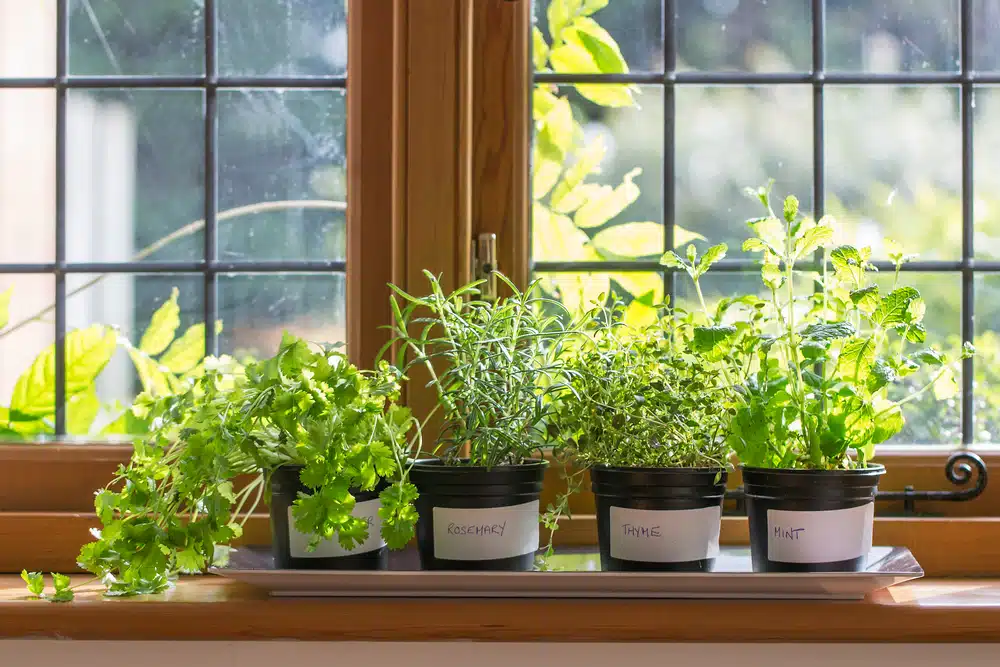
Along with soil, the amount of light your indoor edibles get is another vital consideration. Whilst opinions vary, a commonly-cited figure is that most vegetables need a minimum of 6 hours of direct light whilst certain plants, such as salad greens, can get by on less (4 hours at the lower limit). Fruiting plants, like tomatoes, will need a minimum of 8 hours of direct light.
What is direct light?
Direct light refers to sunlight that is unfiltered. If you imagine yourself as a plant, ask the question: can I see the sun? If you can, and it’s not filtered by clouds, that’s direct light
Indirect light is light that is not in the direct path of the plant but is not dark enough to be considered shade. So, for example, if you stand at a north-facing window in early afternoon, it’ll be very bright but you won’t be able to see the sun. That’s indirect light.
Because there can be shade from adjacent buildings in the city, it’s worth spending some time getting to know what’s going on at your windows. See how many hours of direct sunlight each gets to check that you’re OK to grow.
South and north-facing
As a general rule, south, east and west-facing windows are good for light-intensive plants through late spring, summer and early autumn; with shade-tolerant plants doing well in the remaining months. North-facing windows and south-facing rooms are suitable for shade-tolerant plants through late spring, summer and early autumn.
The reason for the above is that, in the northern hemisphere, the sun rises in the east and sets in the west. This means that south, east, and west-facing locations have the lion’s share of the sun, whilst areas with a north-facing aspect only have it in the early morning and late evening.
Time your planting and seed-sowing so that these spaces are available during the appropriate seasons.
Supplementing With Grow Lights
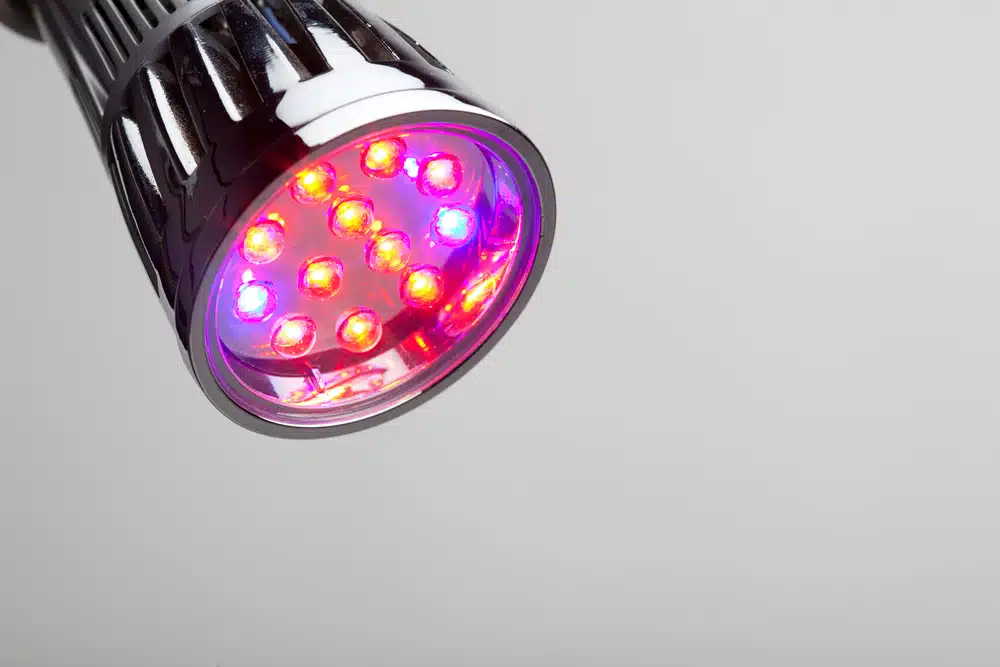
If you’re happy to supplement with a grow light, any season is open to you. Buy a timer and set your light to run for 12 – 14 hours. You can have it running all day (morning to evening) or set it to come on at midday (when the sun is highest in the sky) and turn off when it gets dark.
You only need a full-spectrum fluorescent bulb (plugged into a normal lamp), preferably (as mentioned) with a timer at the plug-socket. Avoid standard (incandescent bulbs) as they don’t produce the required spectrum of light that a plant needs.
Your other option is to go with an LED light. Lower electricity cost is the main benefit. LED lights, though expensive, produce a specific, plant-friendly spectrum that is conducive to growth. They also tend to be longer lasting, up to 50,000 hours compared to a fluorescent bulb’s 10,000 hours.
Keep in mind that plants need to sleep too, so don’t keep the thing running 24 hours a day!
Pots & Containers
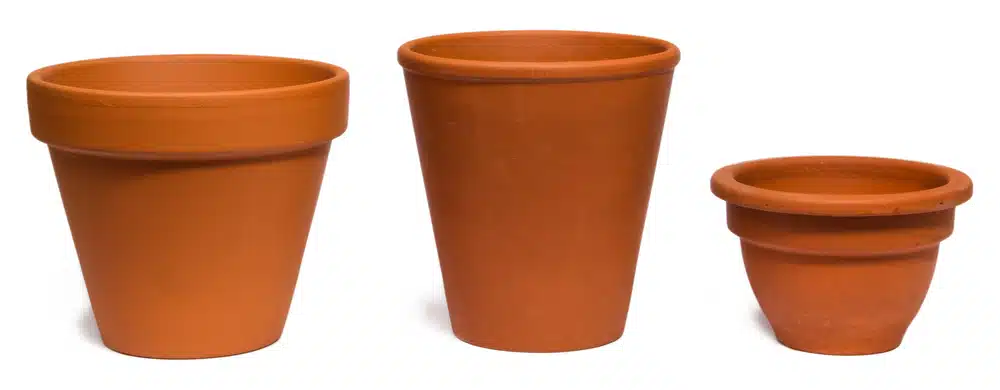
Root depth is your main concern with containers. Most vegetables’ root mass is within the top 6 inches of soil but tap roots (the small spindly roots on the bottom of the main vegetable growth) can extend quite far down. I usually set a minimum of 30 centimetres (12 in.) depth for vegetables that I’m growing for their roots. Lettuces and most plants grown for their leaves obviously don’t need a great deal of depth.
Keep drainage in mind as a key consideration. You’ll want to make sure that all of your pots have holes (either a single hole or several slits) in the bottom and a saucer to catch water.
On a personal note, I’d beg you to consider terracotta pots for the bulk of your plants. Though most containers will do, a plastic-contained environment is ideal for bacteria and fungi to grow and also conducive to damp, water-logged soil in which roots can sit for days and weeks. Alongside looking much better, terracotta allows the soil to “breathe”. Moisture and air can penetrate the porous clay, from both the inside and out, and it also helps maintain stable temperatures.
Other Considerations
Sowing: Sowing indoors, it makes sense to do so directly into the growing container. I suggest sowing thickly in damp soil then thinning some of the seedlings (snipping them off just above the soil line to prevent overcrowding). As a general rule, cover each seed with twice its diameter of soil. Often, this will only be a light scattering.
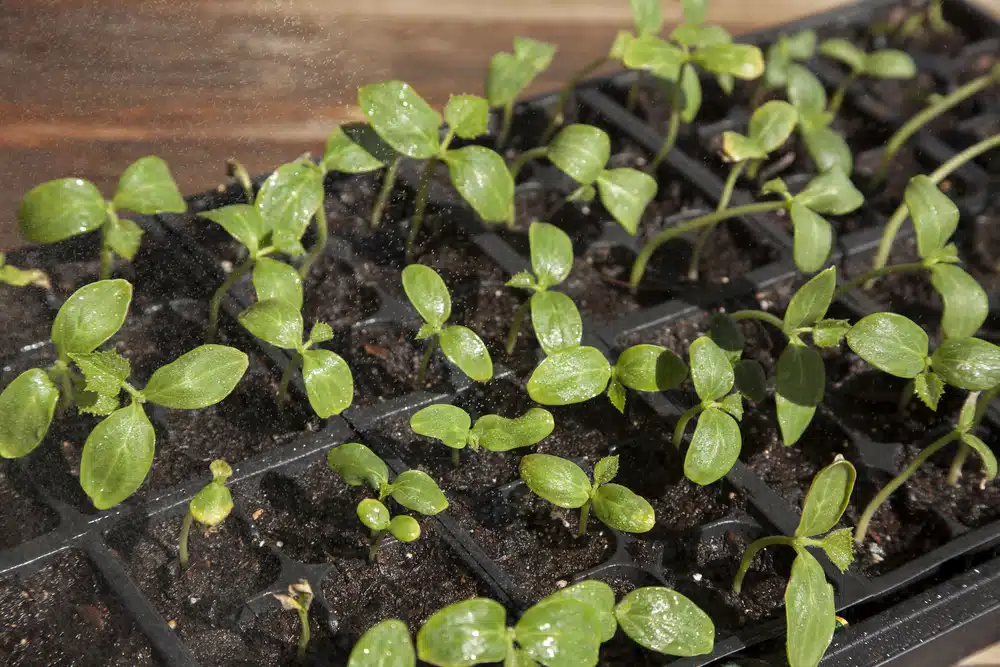
Alternatively, you can use plug trays, although the reason for doing this is usually to start plants inside in spring when it’s too cold outside. Using plugs also allows for the use of specialist sowing compost, which is lower in nutrients than typical compost. In nature, the top level of soil would have been poorer as the nutrients would likely have been washed down to the lower regions. Hence, sowing soil provides a more “natural” way of sowing seeds. It’s not a necessity though.
Watering: You need to water indoor edibles a little more than outdoor plants. Because of the dry and warm conditions, the plants tend to be thirstier. There’s more evaporation, a greater and more consistent need for the plant to cool itself, and the absence of lengthy soaks that rain provides. Wilting leaves (given that the soil is dry) are a definite indicator that you need to increase watering frequency. Equally, you can use your finger to check if the first half-inch of soil or so is dry. If so, give the little fellas a drink!
Feeding: Start a weekly feed 6 – 8 weeks after sowing, at which point the plant will have drawn up the nutrients from the soil. Most feeds consist of equal parts potassium (also called potash), phosphorous and nitrogen, the three main minerals that plants require. Growmore is fine.
Airflow & Spacing: These are important for several reasons. Proper spacing creates an undesirable environment for fungus and bacteria, who love the kind of dark and damp space that overcrowding provides. It also prevents the transfer of diseases between plants. Proper airflow mimics windy outdoor conditions, which strengthen the plant and also aid with temperature control. An open window is usually enough but if you don’t have access to one a fan can be useful, turned on for a few hours every day.
Common Pests and Problems
Though an indoor environment will be more “sterile” than an outdoor one, which invariably leads to less issues, it’s also devoid of insects that act as predators to the pests. That said, fungi, bacteria and insect-pests aren’t always harbingers of the soon-to-come demise of your plants. Remember that your vegetables are living organisms with their own “immune system”. Often, just cutting away the affected growth and giving it a little space can be enough to restore the patient to full health.
Fungus & Mold: Fungus is fairly easy to detect because it’s usually found as a grey or white fuzz on the surface of leaves or stems. The most common type is powdery mildew, which manifests as powder-like, white spots, usually on the surface or underside of leaves. Try a mix of mild soap, water and garlic. If you notice a white fuzz on the soil, spray it immediately, to staunch its spread to the plant. The picture below is of powdery mildew.
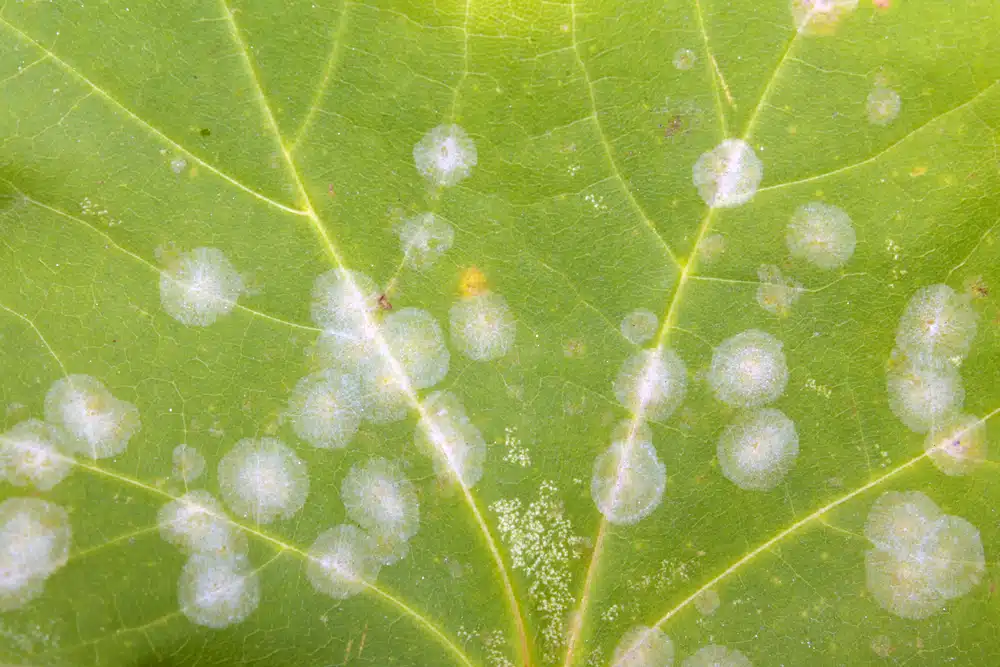
Aphids & Whiteflies: Little white or black insects may appear on plants, especially on tender growth. As I write this I’m trying to deal with an unidentified tiny white pest on my pepper plant. A mix of one teaspoon of soap (as mild as you can get) with a spray-bottle filled with water, sprayed onto the affected area, usually does the trick. You might need to continue for up to five days. If you notice any damage to the plant stop straight away and buy an organic, natural insecticide. The picture below is of whitefly.
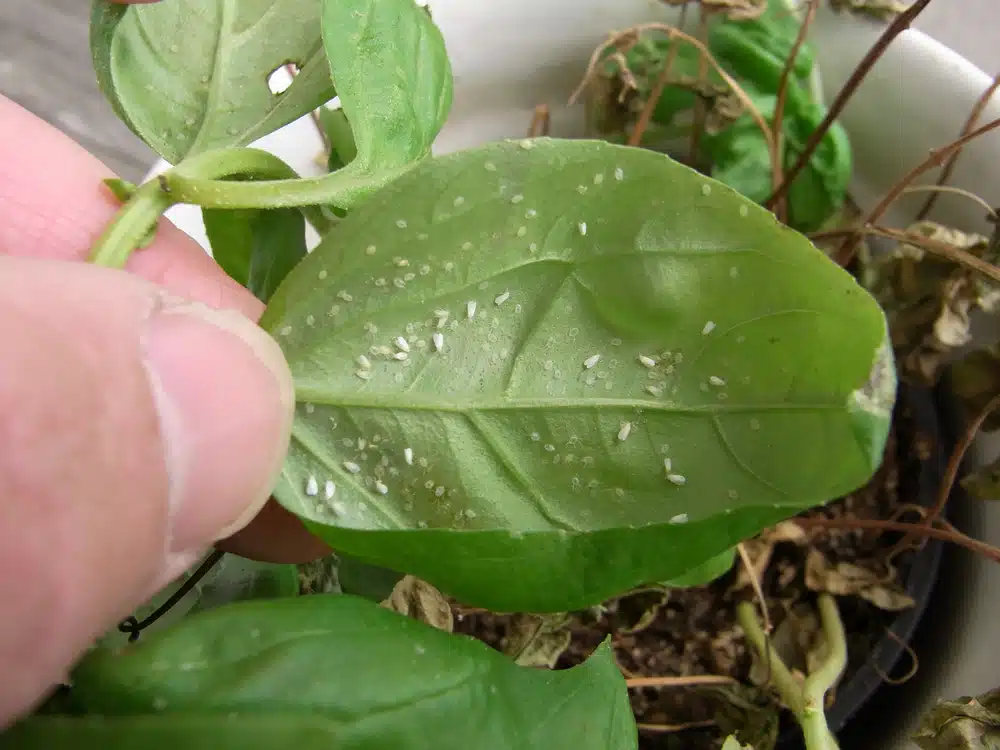
Vegetables
Use the short guides below to get going with your own vegetables.
A Word About Greens
The leaves of many plants cultivated for their roots are also edible, a fact which often runs against popular knowledge.
All of the vegetables listed below, with the exception of tomatoes (which aren’t a vegetable anyway) can be eaten. That said, they’re not always pleasurable to eat raw. By the time a root is mature enough to eat, its leaves are usually tough, occasionally hairy and also show evidence of having contributed to a few insect-dinners.
So my advice is to use them in soups! It stops them from going to waste whilst boiling also remedies those less-than-flavourful aspects.
Lettuces
A well-organized lettuce space can form an indispensable part of your urban garden – one that will provide you with a four-season supply of scrumptious greens.
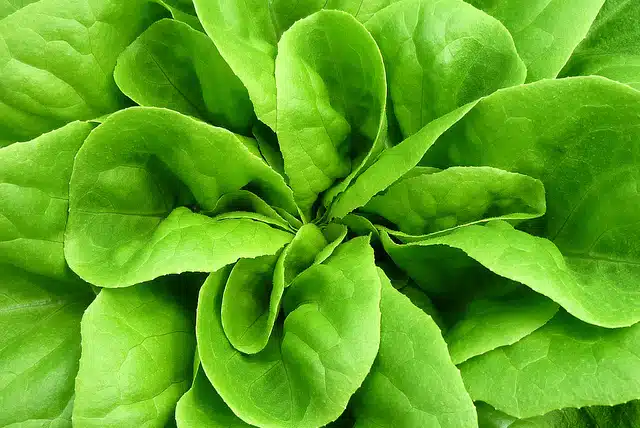
They have lower light and temperature requirements and so make excellent additions to shadier spots in summer (north-facing ledges and south-facing rooms) and bright spots in winter (south-facing windows) when your home is a little cooler. Water them well and give them enough space, 5-10cm (2-4in.) at least between plants. Stagger your sowing, every three weeks or so, for a constant and consistent supply.
Loose-leaf varieties don’t form tight hearts and can be harvested from the outside as they grow. They are probably the easiest to cultivate. Butterhead lettuces form more of a tight centre and are characterised by their waxy leaves. Crisphead and “Cos” varieties both have tight hearts, the latter being distinguished by its tall, narrow shape.
Recommended varieties for containers: Lollo Rosso (loose-leaf), Green Oakleaf (loose-leaf), Red Oakleaf (loose-leaf), Tom Thumb (butterhead).
Radishes
Radishes are amongst the easiest crops to grow and there are many varieties that are well-suited to indoor conditions. You’ll want to go with globular varieties, rather than longer ones, as these form shallower, rounder and usually quicker-developing roots.
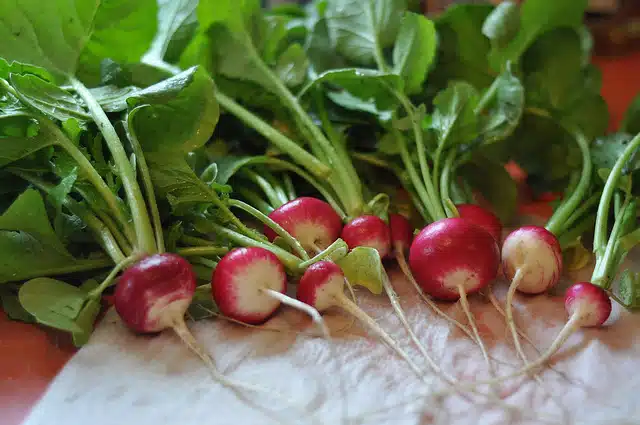
They will tolerate a little shade and can be planted in amongst other crops. You can also use a shallower container (7in. or so minimum).
Recommended varieties for containers: Cherry Belle, Scarlet Globe.
Beetroot
I was drawn to growing beetroot indoors because it’s one of my favourite plants. I love the deep veins and blood-red roots, so unlike any other, but was always beset by mangold-fly outdoors. It was never fatal but I didn’t particularly enjoy having to go through all the leaves cutting out dead parts.
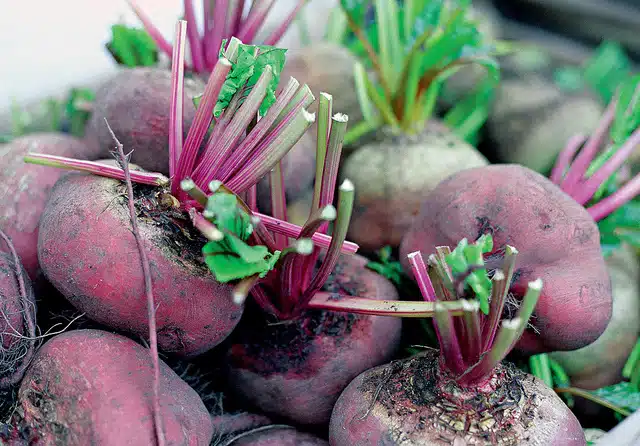
Be sure to choose a good variety. Fast-growing varieties that will develop smaller roots are better suited to containers. They like regular watering, which will also protect against bolting (a term that refers to the plant putting out flowers) by keeping the soil cool. A handful or two of vermiculite to loosen up the soil will also be of benefit.
Recommended varieties for containers: Zeppo, Cylindra (this variety has longer, narrower roots so will require a deeper pot but can be planted more closely).
Turnips
I’m fond of turnips. Not just because I’ve named my blog after them, though that’s part of the reason, but because they’re unfussy, fast-growing crops that are often neglected by gardeners. They also taste great roasted with a little chopped rosemary or thyme (obviously home-grown). They do well in a little shade too.
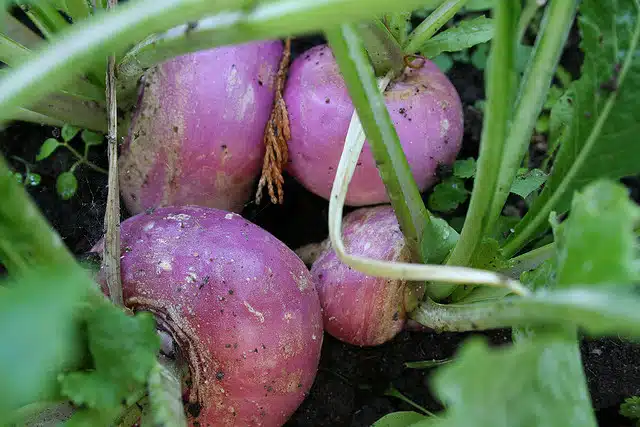
Just as a little bit of history (a nod to Wikipedia again), the Household “Cyclopedia”, an 1881 American housekeeping guide, proclaims the many benefits of the vegetable: “The benefits derived from turnip husbandry are of great magnitude; light soils are cultivated with profit and facility; abundance of food is provided for man and beast; the earth is turned to the uses for which it is physically calculated, and by being suitably cleaned with this preparatory crop, a bed is provided for grass seeds, wherein they flourish and prosper with greater vigor than after any other preparation.”
As with other plants destined for a life indoors, variety selection is paramount. “Flat” varieties form a shallower main root so are better suited to containers, or else you can go with smaller varieties that are designed to be picked at golf-ball size. They’re greedy plants, with lots of foliage, so water and feed regularly and space them at least 6 inches apart.
Recommended varieties for containers: Purple-Top Milan (flat), White-Top Milan (flat), Tiny Pal, Market Express.
Carrots
You’ll need a tall pot and a few handfuls of sand for best results. Looser soils are more conducive to growth (hence the benefit of adding sand or vermiculite). Sow seeds directly (they don’t respond well to transplanting).
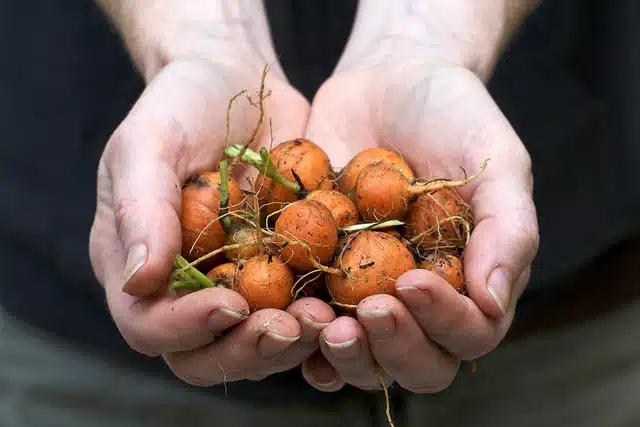
Smaller and round-shaped varieties will do best. If you’re going with a more common tapered variety, consider picking them as baby carrots, which are great eaten raw. They are shade-tolerant but not overly so. Take into account the looser soil by watering regularly and don’t overfeed (cut your weekly feeding schedule in half). If the tops start to shoulder above the surface early or leaves are flopping, just mound some more soil around them.
Recommended varieties for containers: Paris Market, Caracas, Parisienne (these are round varieties which will only grow to be 3 – 5cm long, pictured above).
Tomatoes
Tomatoes are perfect for south-facing windows in summer. There are two types of tomato plant: determinate and indeterminate.
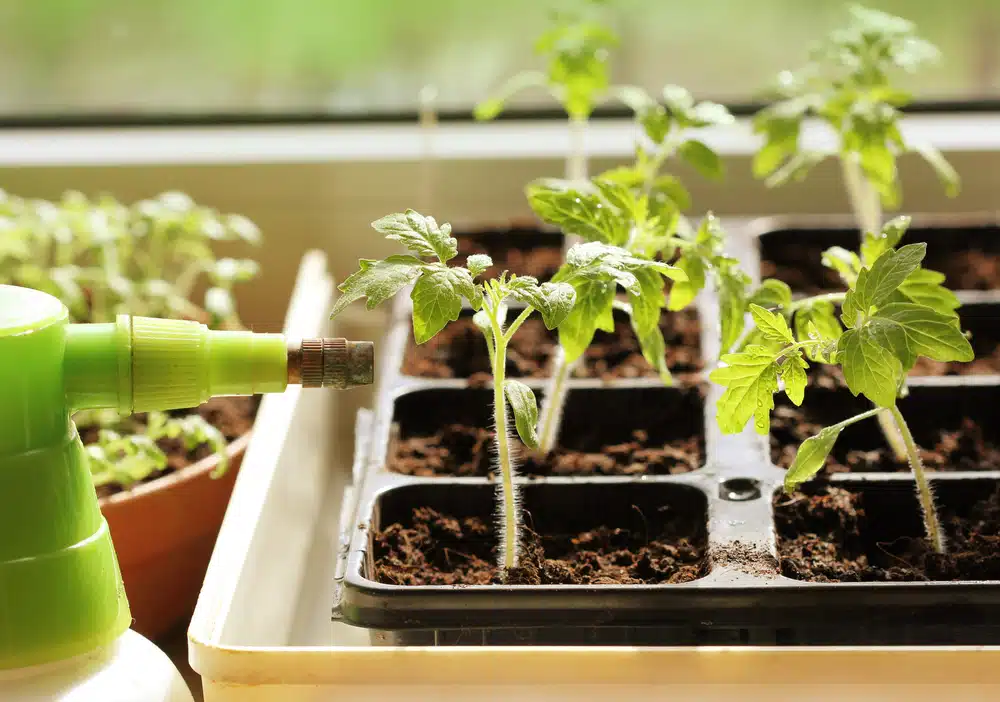
Tomato plants require comparatively more maintenance than other indoor edibles. They’re self-pollinating (both the male and female part s are in the same flower) so help them by gently shaking the stems when the first flowers appear. When fruit appears make sure you’re feeding with a specialist fertilizer on a weekly basis. Equally, you may need to water daily during the hottest summer months, preferably in the morning. Soil should be slightly damp.
Recommended Varieties for Containers: F1 Totem, Tommy Toe, Maskotka.
Final Words
Keep it light-hearted, keep it simple and don’t fret over the corpses. Just re-adjust (it doesn’t really matter what, you’ll eventually find the right factor) and retry. Now get gardening!
Further Reading
Indoor Kitchen Gardening by Elizabeth Millard is a comprehensive and well-illustrated guide.
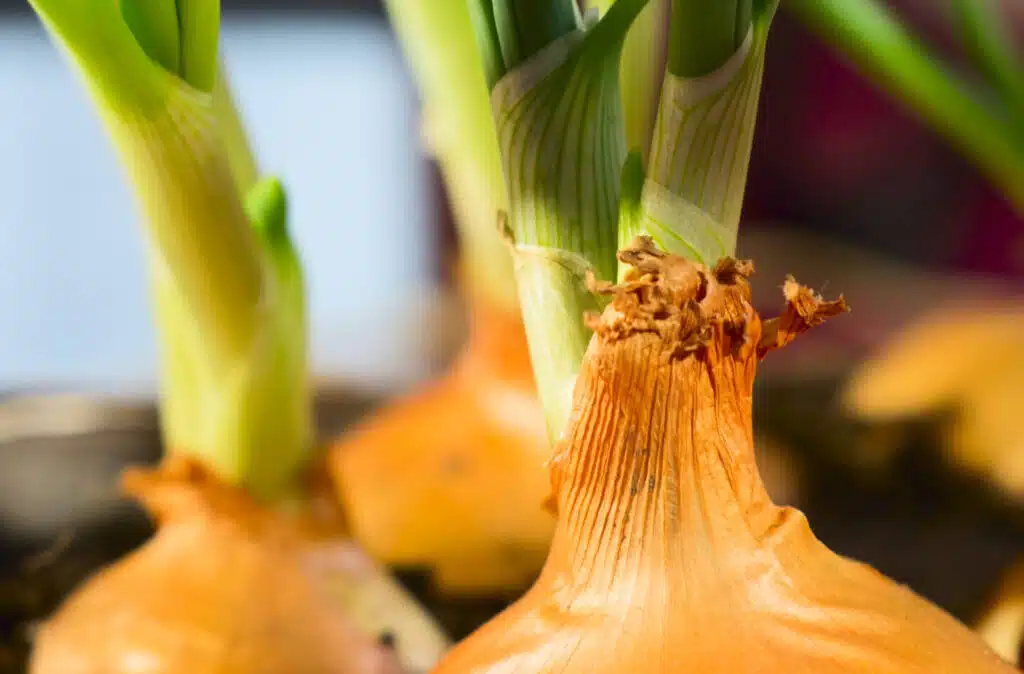
Thanks Dan. Gonna try the aphid suggestion at home!
Let me know how it goes Michele!
Thanks for the great tips. Just wondering about the differences between vermiculite and perlite and their uses.
Hey Heidi, I did a big article about the difference. Hope it helps! https://www.urbanturnip.org/vermiculite-or-perlite/
Best ideas for an indoor garden, thanks for sharing!
Thanks for the kind words regs!
Pingback: Guest Post: Grow Sprouts in Four Simple Steps - Just Glowing with Health